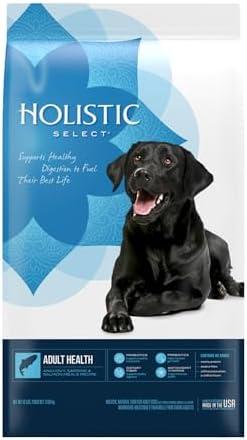Once upon a time in a cozy little town, a dog named Max was struggling with dull fur and low energy. His owner, Sarah, decided to explore a healthier diet. After researching, she discovered that salmon was the secret ingredient. Rich in omega-3 fatty acids, salmon not only boosted Max’s coat shine but also enhanced his vitality. Soon, Max was bounding through the park, full of life and joy. If you want your furry friend to thrive, consider adding salmon to their diet—it’s the best fish for dogs, ensuring they stay healthy and happy!
Contents
- Understanding the Nutritional Benefits of Fish for Dogs
- Identifying the Best Fish Varieties for Canine Health
- Preparing Fish Safely for Your Dogs Diet
- Incorporating Fish into Your Dogs Meal Plan Effectively
- Q&A
Understanding the Nutritional Benefits of Fish for Dogs
Fish is a powerhouse of nutrition that can significantly enhance your dog’s diet. Rich in high-quality protein, fish provides essential amino acids that are crucial for muscle development and overall health. Unlike some meat sources, fish is generally lower in calories and fat, making it an excellent option for dogs that need to maintain a healthy weight. Incorporating fish into your dog’s meals can help them stay lean while still receiving the energy they need for their daily activities.
One of the standout benefits of fish is its high content of omega-3 fatty acids, particularly EPA and DHA. These fatty acids are known for their anti-inflammatory properties, which can be particularly beneficial for dogs suffering from joint issues or skin allergies. Regular consumption of fish can lead to improved skin health, a shiny coat, and reduced shedding. Additionally, omega-3s support cognitive function, making fish a smart choice for dogs of all ages, especially senior pets.
Fish is also a great source of essential vitamins and minerals. It contains vital nutrients such as vitamin D, which aids in calcium absorption and promotes bone health, and selenium, an antioxidant that helps protect cells from damage. Furthermore, fish is rich in B vitamins, which play a key role in energy metabolism and overall vitality. By adding fish to your dog’s diet, you can ensure they receive a well-rounded array of nutrients that contribute to their long-term health.
When selecting fish for your dog, it’s important to choose options that are safe and beneficial. Some of the best choices include:
- Salmon: Packed with omega-3s and protein, it’s a favorite among many dogs.
- Sardines: These small fish are nutrient-dense and can be served whole.
- Herring: Another oily fish rich in omega-3s, great for skin and coat health.
- Whitefish: A lean source of protein that is easy to digest.
By incorporating these fish varieties into your dog’s diet, you can provide them with a delicious and nutritious meal that supports their overall well-being.
Identifying the Best Fish Varieties for Canine Health
When it comes to enhancing your dog’s diet, incorporating fish can be a game-changer. Fish is not only a great source of protein, but it also provides essential fatty acids that promote healthy skin and a shiny coat. Among the various fish options, certain varieties stand out for their nutritional benefits and safety for canine consumption. Choosing the right fish can significantly contribute to your dog’s overall health and well-being.
**Salmon** is one of the top contenders, rich in omega-3 fatty acids, which are known to support heart health and reduce inflammation. This fish is also packed with vitamins and minerals, including vitamin D and selenium, which are vital for maintaining a strong immune system. However, it’s crucial to ensure that salmon is cooked properly to eliminate the risk of parasites that can harm your dog.
Another excellent choice is **sardines**. These small fish are not only affordable but also loaded with nutrients. Sardines are high in omega-3s and are a fantastic source of calcium, especially when served with their bones. Their small size means they are less likely to contain harmful toxins, making them a safer option for regular feeding. Plus, their strong flavor is often irresistible to dogs, making mealtime more enjoyable.
**Mackerel** is also worth considering, as it is rich in healthy fats and provides a good amount of protein. This fish is particularly beneficial for dogs with dry skin or allergies, as the omega-3s can help alleviate these issues. Just like salmon, mackerel should be cooked thoroughly to ensure it is safe for your furry friend. By incorporating these fish varieties into your dog’s diet, you can help promote a healthier lifestyle and enhance their overall quality of life.
Preparing Fish Safely for Your Dogs Diet
When incorporating fish into your dog’s diet, it’s crucial to prioritize safety to ensure your furry friend enjoys the benefits without any risks. Start by selecting **fresh, high-quality fish** from reputable sources. Avoid fish that have a strong odor or appear discolored, as these can indicate spoilage. Always check for any signs of parasites or abnormalities, as these can pose health risks to your dog.
Before serving fish to your dog, it’s essential to **remove all bones**. Fish bones can splinter and cause choking or serious injuries to your dog’s digestive tract. Opt for boneless fillets or carefully debone the fish yourself. Additionally, cooking the fish is highly recommended; this not only kills harmful bacteria and parasites but also makes it easier for your dog to digest. Steaming, baking, or grilling without added oils or seasonings is the best approach.
Be mindful of the type of fish you choose, as some varieties are safer and more nutritious than others. Fish such as **salmon, sardines, and trout** are excellent options due to their high omega-3 fatty acid content, which promotes healthy skin and coat. However, avoid fish that are high in mercury, like swordfish and king mackerel, as these can lead to long-term health issues. Always consult with your veterinarian to determine the best fish options tailored to your dog’s specific dietary needs.
introduce fish into your dog’s diet gradually. Start with small portions to monitor for any adverse reactions or allergies. If your dog shows signs of discomfort or digestive issues, discontinue feeding fish and consult your veterinarian. By taking these precautions, you can safely enhance your dog’s diet with the nutritional benefits of fish, ensuring they thrive and enjoy their meals.
Incorporating Fish into Your Dogs Meal Plan Effectively
When considering the addition of fish to your dog’s diet, it’s essential to choose varieties that are not only safe but also packed with nutrients. **Salmon** is a top contender, rich in omega-3 fatty acids, which promote a healthy coat and skin while supporting joint health. Ensure that the salmon is cooked thoroughly to eliminate any harmful parasites, and always avoid feeding your dog raw fish to prevent potential health risks.
Another excellent option is **sardines**, which are small, oily fish that are loaded with essential nutrients. These tiny powerhouses are high in protein, calcium, and omega-3s, making them a fantastic addition to your dog’s meal plan. Sardines can be served canned (in water, without added salt) or fresh, providing a tasty treat that dogs often love. Just be sure to remove any bones if you’re using fresh sardines.
**Mackerel** is also a nutritious choice, offering a rich source of omega-3 fatty acids and vitamin D. This fish can help improve your dog’s cardiovascular health and support cognitive function. When incorporating mackerel into your dog’s diet, opt for fresh or canned varieties that are free from added preservatives or sauces. Moderation is key, as mackerel can be high in mercury, so it’s best to serve it as an occasional treat rather than a daily staple.
Lastly, consider **cod**, which is a lean fish that provides a good source of protein without excessive fat. Cod is gentle on the stomach, making it suitable for dogs with sensitive digestive systems. It can be cooked and flaked into your dog’s regular meals or served as a standalone treat. As with all fish, ensure it is cooked properly and free from bones to keep your furry friend safe and healthy.
Q&A
-
What types of fish are safe for dogs to eat?
Safe fish options for dogs include:
- Salmon – Rich in omega-3 fatty acids, beneficial for skin and coat health.
- Sardines - Packed with nutrients and can be served whole.
- Whitefish – A lean protein source that is easy to digest.
- Trout – Another excellent source of omega-3s, but ensure it is cooked properly.
-
Are there any fish that dogs should avoid?
Yes, certain fish can be harmful to dogs, including:
- Raw fish – Can contain parasites that may harm your dog.
- Fish high in mercury – Such as swordfish and shark, which can lead to toxicity.
- Fish with bones – Can pose a choking hazard or cause internal injury.
-
How should fish be prepared for dogs?
To ensure safety and health benefits, fish should be:
- Cooked thoroughly – Avoid raw fish to eliminate parasites and bacteria.
- Deboned – Remove all bones to prevent choking hazards.
- Served plain – Avoid adding seasoning, oils, or sauces that may be harmful.
-
What are the health benefits of feeding fish to dogs?
Incorporating fish into your dog’s diet can provide numerous health benefits, such as:
- Improved coat condition – Omega-3 fatty acids promote a shiny and healthy coat.
- Joint health - Anti-inflammatory properties can help with arthritis and joint pain.
- Enhanced brain function - Omega-3s support cognitive health and development.
- Boosted immune system – Nutrients in fish can strengthen your dog’s immune response.
choosing the right fish for your dog can enhance their diet and overall health. Prioritize options like salmon or sardines, ensuring they are prepared safely. Invest in your pet’s well-being—because a healthy dog is a happy dog!

大家好,我是彼得潘,專業的手法身體治療師。我喜歡探索和研究各種主題,並透過與人工智慧的合作分享專業、實用、有趣的文章。我們定期進行人工審核,以確保內容的準確性。如果您發現文章中有任何不準確的地方,請隨時與我們聯繫,我們會及時糾正。您可以透過 [email protected] 與我們聯繫。



